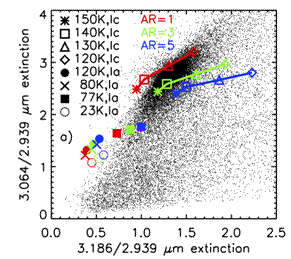|
STATUS:
09.12.2012
Spacecraft Status
The AIM spacecraft continues to operate nominally. The last bitlock occurred on July 29. During this period of bitlock we commanded the CDE instrument off since it’s no longer operational. The operations team has been studying the lesson's learned from the SORCE spacecraft and updated the Electrical Power System Fault Detection and Correction algorithms. The new algorithms will allow AIM to continue to operate in the event the battery should start to exhibit signs of degradation. These modifications will be uplinked during the next bitlock opportunity.
Instrument Status
SOFIE: The conditions associated with PMCs are generally thought to favor cubic ice (Ic), however, it has been suggested that PMCs may originate as amorphous ice (Ia) through homogeneous nucleation at temperatures below ~130 K [Zasetsky et al., 2009; Murray and Jensen, 2010]. SOFIE observations indicate that PMCs are composed of cubic ice, and that amorphous ice is either absent in PMCs or cannot be detected [Hervig and Gordley, 2010]. The Figure below shows the agreement between SOFIE and model predictions for cubic ice, but that predictions for amorphous ice do not match the measurements. SOFIE extinction ratios are shown for June 1 – August 20, 2008 at PMC altitudes (81 - 91 km), and only observations that were greater than the noise. SOFIE data are compared to model results for a range of particle axial ratios (AR) and either cubic or amorphous ice. Model results for cubic ice (Ic) used the Clapp et al. [1995] refractive indices. Model results for amorphous ice (Ia) used indices from Hudgins et al. [1993] (80 and 120K), Mukai and Kraetschmer [1986] (23K), and Leger et al. [1983] (77K). The SOFIE results suggest either that homogeneous nucleation does not occur, or that amorphous ice resulting from homogeneous nucleation is a transient phase due to rapid transformation into crystalline ice. Meteoric smoke is still considered the most likely ice nuclei under typical PMC conditions [Rapp and Thomas, 2006]. This idea was recently supported by SOFIE observations which indicate that PMC particles contain small amounts of smoke [Hervig et al., 2012].

CIPS: We have now completed 11 seasons of CIPS observations. CIPS continues to perform well, with no health issues. PMC frequencies for all seasons at 85° latitude and 70° latitude are shown in the figure here for ascending node (left) and descending node (right) observations. Day-to-day variations at the two latitudes are clearly different, suggesting that the CIPS observations, because of their broad coverage, provide leverage for understanding the underlying physics. The early start to the SH09 season was explained by Karlsson et al. [2011]. Variability in the season onset observed here for other years is likely caused by a combination of changes in zonal winds in the SH stratosphere and the solar cycle, as described by Benze et al. [2012], with a possible contribution from rocket launches. Differences in day-to-day variability in different seasons and at different latitudes are at least partly controlled by atmospheric dynamics, the details of which are just beginning to be unraveled.

References:
Karlsson, B., C. E. Randall, T. G. Shepherd, V. L. Harvey, J. Lumpe, K. Nielsen, S. M. Bailey, M. Hervig, and J. M. Russell III (2011), On the seasonal onset of polar mesospheric clouds and the breakdown of the stratospheric polar vortex in the Southern Hemisphere, J. Geophys. Res., 116, D18107, doi:10.1029/2011JD015989.
Benze, S., C. E. Randall, B. Karlsson, V. L. Harvey, M. T. DeLand, G. E. Thomas, and E. P. Shettle (2012), On the onset of polar mesospheric cloud seasons as observed by SBUV, J. Geophys. Res., 117, D07104, doi:10.1029/2011JD017350.
EPO Update:
On June 17, 2012, Gloria Faus, conducted an AIM/PBL presentation at the NASA Innovations in Climate Education (NICE) DUST workshop, implemented by Hampton University, at Graves Mt. Lodge in Syria, VA. She demonstrated how she and her students used AIM content to develop a Problem Based Learning (PBL) module. Her presentation will be posted at http://dust.hamptonu.edu Ms. Faus is a former AIM workshop participant who continues to work with AIM outreach.
New ISS Photo
eol.jsc.nasa.gov
The Gateway to Astronaut Photography of Earth, a beautiful NLC Photo from the ISS taken summer 2012.

click to view full size image
|
